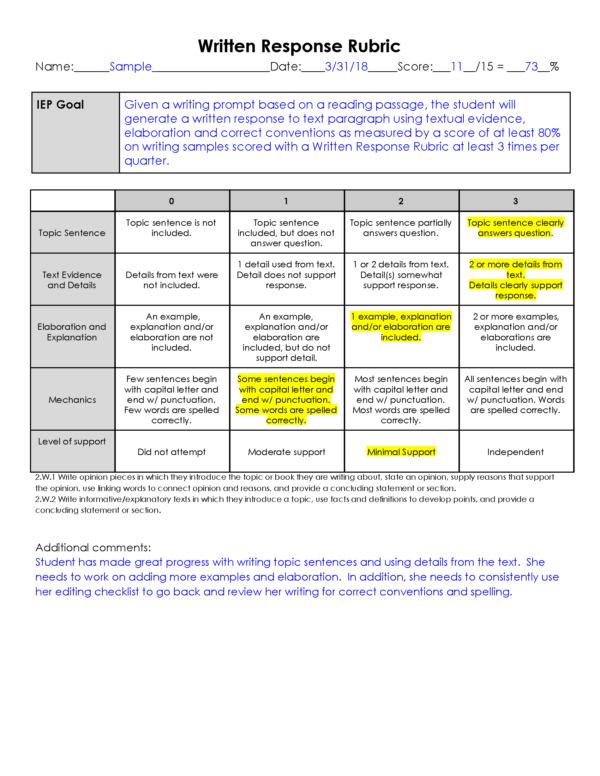Rubrics have been essential for my resource program this year. Rubrics are efficient tools to assess authentic student learning and growth. Instead of measuring a skill as correct/incorrect or simply generating a percentage score, rubrics allow us to assess holistically and offer a chance to incorporate quantitative and qualitative data.
Here are the top 5 benefits to using rubrics:
- Evaluate performance: Rubrics are used to evaluate student work by measuring it against set scoring criteria. Using the scoring criteria allows teachers to objectively complete an error analysis, look for skill gaps, and determine the level of support or cues needed to complete a task or assignment. I use rubrics to assess progress towards IEP goals throughout the quarter. In addition, I use rubrics to analyze work samples as part of initial evaluations and 3 year reevaluations to supplement the standardized testing data and generate baseline data for IEP goals.
- Provide hierarchy of skill development: Rubrics include a task analysis and standards-aligned progression of skills required for mastery. This is helpful not only in showing student growth, but also helpful in designing instruction to address the specific skill gaps students may have.
- Communicate with parents: Using the actual rubric itself or language from the rubric indicators on progress updates, provides parents with detailed information about how their child is progressing. It communicates specific information about skills and growth rather than just a score on an assessment. This year I added the criteria category of “Level of Support” with the indicators of “Independent,” “Minimal Support,” “Moderate Support,” and “Did not attempt.” This has been extremely helpful when communicating progress.
- Define performance expectations: Teachers can use rubrics to set expectations for performance with students prior to starting an assignment. I use the rubric to assess work completed during the modeling phase of instruction with the class. For example, after I model how to create a written response to text, I have the students check my work using the rubric to see if I included the essential components. Students can also use the rubrics to self-assess and self-correct their work before turning in assignments.
- Measure progress across time and settings: Rubrics can be used with specifically designed tasks or assignments for progress monitoring, or with authentic curriculum-based work samples. I attach the scoring rubrics to student work samples and save them in individualized portfolio binders. Students are able to see their growth throughout the school year, reflect on the progress, and set specific goals for improvement.
Rubrics could be using in general education, special education, for all subject areas, as well as for behavioral and social goals. Click on the links below to see sample rubrics I’ve individualized for students in my resource program. The rubrics should be modified and customized to meet the needs of students in your classroom based on grade level standards, IEP goals and specific learning needs.
Download our fully editable rubrics here! The following rubrics for IEP goal progress monitoring are included:
- Foundational Reading Skills
- Reading Comprehension: Informational Text
- Reading Comprehension: Narrative
- Expository Writing
- Narrative Writing
- Written Response to Text
- Math Problem Solving
- Behavior and Social Skills
Considerations for IEP Goals: When developing new IEP goals, write goals measured by the rubric’s criteria where appropriate. For example, “Given a writing prompt based on a reading passage, the student will generate a written response to text using textual evidence, elaboration and correct conventions as measured by a score of at least #% on writing samples scored with a ‘Written Response to Text Rubric’ at least 3 times per quarter.” When updating progress on goals at the end of each quarter, I report the overall percentage on the scored rubric, along with details in the comment section to elaborate on the student’s progress. Using indicators directly from the rubric helps to make the comments specific and informative. Furthermore, it is useful to attach the rubric to a student’s IEP. This helps parents understand how you will be measuring the skill and stays with the student if the student moves to another school.
Overall, I have found that rubrics have strengthened my ability to provide consistent, accurate progress data for students in an efficient manner. Rubrics can easily show growth over time and illustrate clear information about specific skills and progress towards standards. For more special education tips and tools, check out this blog.

